Protestant Cemetery, Rome
The Cimitero Acattolico ('Non-Catholic Cemetery') of Rome, often referred to as the Cimitero dei protestanti ('Protestant Cemetery') or Cimitero degli Inglesi ('Englishmen's Cemetery'), is a private cemetery in the rione of Testaccio in Rome. It is near Porta San Paolo and adjacent to the Pyramid of Cestius, a small-scale Egyptian-style pyramid built between 18 and 12 BC as a tomb and later incorporated into the section of the Aurelian Walls that borders the cemetery. It has Mediterranean cypress, pomegranate and other trees, and a grassy meadow. It is the final resting place of non-Catholics including but not exclusive to Protestants or British people. The earliest known burial is that of a University of Oxford student named Langton in 1738. The English poets John Keats and Percy Bysshe Shelley are buried there.
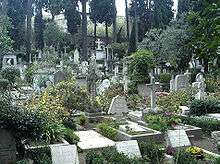 | |
| Details | |
|---|---|
| Established | 1716 |
| Location | |
| Country | Italy |
| Coordinates | 41.876°N 12.480°E |
| Type | Public |
| Style | 18th–19th century European |
Burials
John Keats
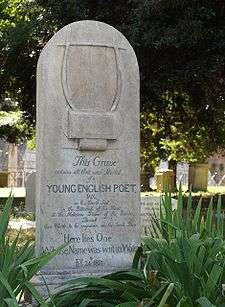
Keats died in Rome of tuberculosis at the age of 25, and is buried in the cemetery. His epitaph, which does not mention him by name, is by his friends Joseph Severn and Charles Armitage Brown, and reads:
This grave contains all that was mortal, of a young English poet, who on his death bed, in the bitterness of his heart, at the malicious power of his enemies, desired these words to be engraven on his tombstone: Here lies one whose name was writ in water.
Percy Bysshe Shelley
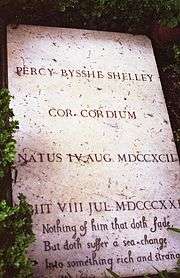
Shelley drowned in 1822 in a sailing accident off the Italian Riviera. When his body washed up upon the shore, a copy of Keats' poetry borrowed from Leigh Hunt was discovered in his pocket - doubled back - as though it had been put away in a hurry. He was cremated on the beach near Viareggio by his friends, the poet Lord Byron and the English adventurer Edward John Trelawny. His ashes were sent to the British consulate in Rome, who had them interred in the Protestant Cemetery some months later.
Shelley's heart supposedly survived cremation and was snatched out of the flames by Trelawny, who subsequently gave it to Shelley's widow, Mary. When Mary Shelley died, the heart was found in her desk wrapped in the manuscript of "Adonais," the elegy Shelley had written the year before upon the death of Keats, in which the poet urges the traveller, "Go thou to Rome ...".
Shelley and Mary's three-year-old son William was also buried in the Protestant Cemetery.
Shelley's heart[1] was finally buried, encased in silver, in 1889, with the son who survived him, Sir Percy Florence Shelley,[2] but his gravestone in the Protestant Cemetery is inscribed: Cor cordium ("heart of hearts"), followed by a quotation from Shakespeare's The Tempest:
Nothing of him that doth fade,
But doth suffer a sea change,
Into something rich and strange.
Other burials
_-_Foto_Giovanni_Dall'Orto%2C_31-March-2008.jpg)
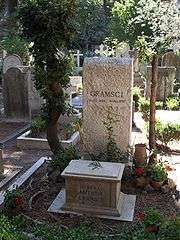
.jpg)
.jpg)
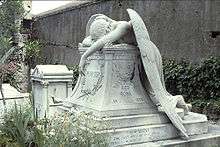
- Arthur Aitken (1861–1924), British military commander
- Walther Amelung (1865–1927), German classical archaeologist
- Hendrik Christian Andersen (1872–1940), sculptor, friend of Henry James
- R. M. Ballantyne (1825–1894), Scottish novelist
- John Bell (1763–1820), Scottish surgeon and anatomist
- Dario Bellezza (1944–1996), Italian poet, author and playwright
- Karl Julius Beloch (1854–1929), German classical and economic historian
- Martin Boyd (1893–1972), Australian novelist and autobiographer
- Pietro Boyesen (1819–1882), Danish photographer
- Karl Briullov (1799–1852), Russian painter
- Giorgio Bulgari (1890–1966), Italian businessman, grandson of Sotirios Bulgari, the founder of Bulgari
- Andrea Camilleri (1925–2019), Italian novelist
- Asmus Jacob Carstens (1754-1798), Danish-German painter
- Jesse Benedict Carter (1872–1917), American Classical scholar
- Enrico Coleman (1846–1911), artist and orchid-lover
- Gregory Corso (1930–2001), American beat generation poet
- Richard Henry Dana, Jr. (1815–1882), American author of Two Years Before the Mast
- Luce d'Eramo (1925-2001), Italian writer
- Frances Minto Elliot (1820–1898), English writer
- Robert K. Evans (1852–1926), United States Army Brigadier General
- Robert Finch (1783–1830), English antiquary and connoisseur of the arts
- Arnoldo Foà (1916–2014), Italian actor
- Karl Philipp Fohr (1795–1818), German painter
- Maria Pia Fusco (1939-2016), Italian screenwriter and journalist[3]
- Carlo Emilio Gadda (1893–1973), Italian novelist
- John Gibson (1790–1866), Welsh sculptor, student of Canova
- August von Goethe (1789–1830), son of Johann Wolfgang von Goethe; his monument features a medallion by Bertel Thorvaldsen
- Antonio Gramsci (1891–1937), Italian philosopher, leader of the Italian Communist Party
- Richard Saltonstall Greenough (1819–1904), American sculptor
- Augustus William Hare (1792–1834), English author
- William Stanley Haseltine (1835–1900), American painter and draftsman
- William H. Herriman (1829–1918), American art collector
- Ursula Hirschmann (1913–1991), German anti-fascist activist and an advocate of European federalism
- Wilhelm von Humboldt (1794–1803), son of the German diplomat and linguist Wilhelm von Humboldt
- Vyacheslav Ivanov (1866–1949), Russian poet, philosopher, and classical scholar
- Chauncey Ives (1810–1894), American sculptor
- Gualtiero Jacopetti (1919–2011), Italian director of documentary films
- Dobroslav Jevđević (1895–1962), Serbian World War II commander
- John Keats (1795–1821), English poet
- Lindsay Kemp (1938–2018), British dancer, actor, teacher, mime artist, and choreographer
- August Kestner (1777–1853), German diplomat and art collector
- Adolf Klügmann (1837–1880), German classical archaeologist and numismatist
- Antonio Labriola (1843–1904), Italian Marxist theoretician
- Belinda Lee (1935–1961), British actress
- James MacDonald (1741-1766), Scottish baronet and scholar; his tombstone was designed by G.B. Piranesi
- Hans von Marées (1837–1887), German painter
- George Perkins Marsh (1801–1882), American Minister to Italy 1861–1882, author of Man and Nature
- Richard Mason (1919 - 1997), British author of The World of Suzy Wong
- Malwida von Meysenbug (1816–1903), German author
- Hugh Andrew Johnstone Munro (1819–1885), British classical scholar
- Ernest Nash (1898-1974), German-American scholar, archaeological photographer
- E. Herbert Norman (1909–1957), Canadian diplomat and historian
- Dora Ohlfsen-Bagge (1869–1948), Australian sculptor, and her partner, Hélène de Kuegelgen (died 1948)
- D'Arcy Osborne, 12th Duke of Leeds (1884–1964), British diplomat and last Duke of Leeds
- Thomas Jefferson Page (1808–1899), commander of United States Navy expeditions exploring the Río de la Plata
- Milena Pavlović-Barili (1909–1945), Serbian Italian artist
- John Piccoli (1939-1955), son of American artists Juanita and Girolamo (Nemo) Piccoli of Anticoli Corrado
- Bruno Pontecorvo (1913–1993), Italian nuclear physicist
- G. Frederick Reinhardt (1911–1971), U.S. Ambassador to Italy, 1961–1968; administrator of this cemetery, 1961–1968
- Heinrich Reinhold (1788–1825), German painter, draughtsman, engraver; his tombstone features a medallion by Bertel Thorvaldsen
- Sarah Parker Remond (1826–1894), African American abolitionist and physician
- Amelia Rosselli (1930–1996), Italian poet
- Gottfried Semper (1803–1879), German architect
- Joseph Severn (1793–1879), English painter, consul in Rome, and friend of John Keats, beside whom he is buried
- Percy Bysshe Shelley (1792–1822), English poet
- Franklin Simmons (1839–1913), American sculptor and painter
- William Wetmore Story (1819–1895), American sculptor, buried beside his wife, Emelyn Story, under his own Angel of Grief
- Niklāvs Strunke (1894–1966), Latvian painter
- Pavel Svedomsky (1849–1904), Russian painter
- John Addington Symonds (1840–1893), English poet and critic
- Manfredo Tafuri (1935–1994), Italian architectural historian
- Tatiana Tolstaya (1864-1950), Russian painter and memoirist and daughter of Leo Tolstoy and Sophia Tolstaya
- Edward John Trelawny (1792–1881), English author, friend of Percy Bysshe Shelley, beside whose ashes he is buried
- Elihu Vedder (1836–1923), American painter, sculptor, graphic artist
- Shefqet Vërlaci (1877–1946), Prime Minister of Albania
- Wilhelm Friedrich Waiblinger (1804–1830), German poet and biographer of Friedrich Hölderlin
- J. Rodolfo Wilcock (1919–1978), Argentine writer, poet, critic and translator
- Friedrich Adolf Freiherr von Willisen (1798–1864), Prussian General and Ambassador to the Holy See
- Constance Fenimore Woolson (1840–1894), American novelist and short story writer, friend of Henry James
- Helen Zelezny-Scholz (1882–1974), Czech-born sculptor and architectural sculptor
References
- Or, some have suggested, his liver. See "Possibly Not Shelley's Heart?", New York Times, 28 June 1885.
- Lexa Selph, "Shelley's Heart", Letter to the Editor, The New York Times, 8 June 1985.
- Bandettini, Anna (14 December 2016). "Morta Maria Pia Fusco, una vita di passione per il cinema". Repubblica.it (in Italian). Retrieved 28 February 2019.
Further reading
- Stanley-Price, Nicholas (2014). The Non-Catholic Cemetery in Rome: its history, its people and its survival for 300 years. Rome: Non-Catholic Cemetery in Rome. ISBN 978-88-909168-0-9.
- Antonio Menniti Ippolito, Il Cimitero acattolico di Roma. la presenza protestante nella città del papa, Roma, Viella, 2014, ISBN 978-88-6728-114-5
External links
| Wikimedia Commons has media related to Protestant Cemetery, Rome. |
- On-line database of tombs and deceased
- Cemetery website (in Italian and English)
- The Mirror of Literature, Amusement, and Instruction Volume 10, No. 285, 1 December 1827, Project Gutenberg E-text contains an article entitled "Protestant Burial-Ground At Rome"
- The Keats-Shelley House in Rome
- GPS coordinates you need to use to find the graves of famous people in the Non-Catholic Cemetery
- Elisabeth Rosenthal. "A Cemetery of Poets Is in Crisis in Rome", International Herald Tribune, 8 February 2006